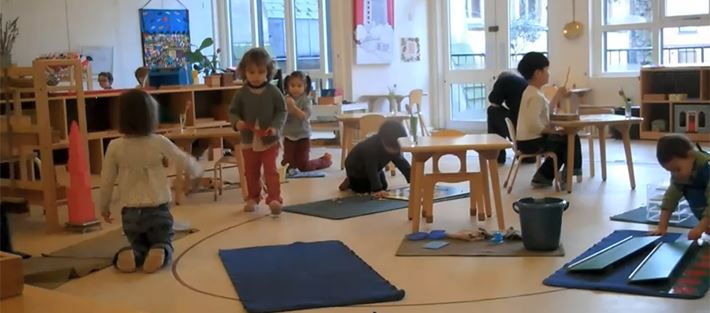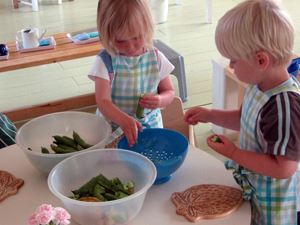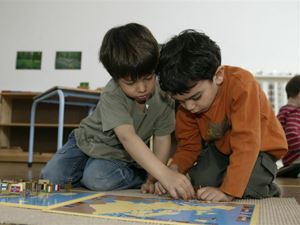
Children's House
The Montessori environment for children between the ages of 3 and 6 years is called the Children’s House.
Around 2 ½ and 3 years children move into this class from an Infant Community but for many, joining this class is their first experience of nursery school.
The three-year age range in the Children’s House enables it to form a mini community in which the younger ones can learn from watching what the older ones do and the older ones increase in confidence and reaffirm their own knowledge by helping the younger ones to carry out activities. The community functions on respect for each other and the activities they all share.
The layout encourages children to return items to the shelves ready for their classmates to use and there is only one of each piece of material to help children develop patience and self-control. Materials are interrelated so that one child may be cutting fruit up because they want a snack but another may be washing up, another washing cloths and another ironing – all activities for their own sake and yet all activities that serve the needs of another.
The capacity to share and work collaboratively emerges as a natural consequence of the way in which the learning activities function together.
The Children’s House environment is laid out in a way that helps children to choose and access their activities for themselves so that they are able to learn at their own pace. All of the materials are child-sized and are placed on

low shelves in an order that children can see and which helps them to decide what they might be able to do next. Having chosen what they want to do children may engage in an activity for as long as they want to, exploring and finding things out for themselves.
Materials are self-correcting; children can discover when they have made a mistake and their confidence is nurtured when they are able work independently or with each other to solve problems.
Activities are offered in a way that appeals to the way that the child under six learns; they are hands-on and may be explored using all of their senses. The Montessori teacher introduces the children to activities by showing rather than telling them what to do - at this age children learn more from what adults do than from what they say.
When the child first joins the class, the teacher (also known as a Montessori guide) will offer several activities which they may carry out individually because young children like to do things by themselves. But as the children progress they are offered games in which they can interact, co-operate and share their understanding. The mixed age range of 3 to 6 years allows children to observe and collaborate in their learning and development.
The Children’s House is filled with brightly coloured beautiful, scientifically designed, aesthetically pleasing materials – the shelves entice the child with boxes full of beads, crafted wooden shapes and delicate, ceramic jugs and bowls.

The Sensorial materials are designed to help refine the children’s senses so that may perceive differences in size, shape, colour, texture, temperature, weight, smell, taste, sound and pitch more clearly, while also acquiring the language to communicate these concepts.
The hands-on materials enable children to explore in a scientific way - to be able to compare, contrast, sort and discriminate the finest of differences between things; these skills are used when learning how to read and write, understand the world of numbers and to learn about the animals, plants, music and art in the world around them.
In the Children’s House the teacher is trained to understand that given an enabling environment and the right support, the child is able to develop himself. The Montessori teacher’s role is:
- To prepare and maintain an environment to fulfil the needs of the child
- To connect the child to the activities in the environment and then
- Make it possible for the child to be engaged in activity without being disturbed
The main tool that the Montessori teacher has for this is the skill of observation – observation lies at the heart of the Montessori approach to education. The Montessori teacher must observe to find out what the child chooses for himself, what he spends time focusing on and how he manages with it in order to find out what interests are driving the child’s development at a particular moment and what help he needs. These observations are used to decide what to offer the child next and how to help the child progress. When connecting the child to activities the Montessori teacher is both lively and enticing but once the child is engaged she is passive and retiring.
This scientific approach to observation helps the Montessori teacher to guide the child to follow his own developmental timetable - to learn at his own pace. So in the relationship between teacher and child, both are the guides – the child is guided by the teacher and the teacher is guided by the child.

